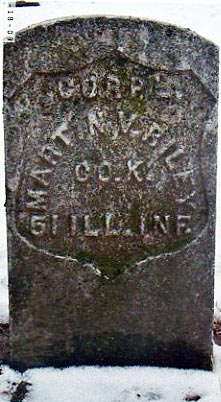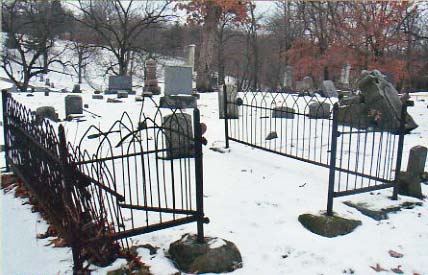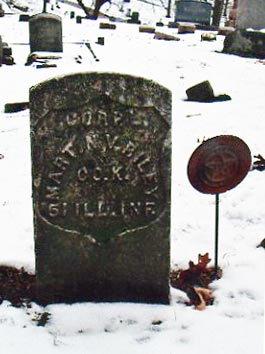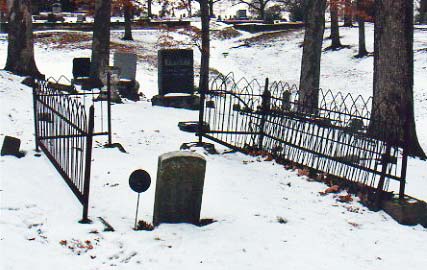 Martin Riley
Martin Riley
Corporal, Company K
Martin Vanburen Riley was born in Hagerstown, Maryland in about 1839. His parents were John and Mary Riley, both Pennsylvania-born. Martin moved west in the 1850s. The 1860 census shows him living as a boarder and day laborer in a household in Fountain Green Township, Hancock County, Illinois.
Martin enlisted in the Fifty-First Illinois on January 21, 1862 at Fountain Green. By that time, many men of the regiment had been in training at Camp Douglas, Chicago for three or four months. Riley was promoted to corporal yet in the Spring of 1862, soon after the regiment left Camp Douglas for "the war."
Martin lived through the first year and a half of the regiment's history without coming to grief of even a small kind—he was never sick and never wounded. He was mentioned officially and honorably for his sturdy behavior at the Battle of Stones River. While many of Company K fell, dead and wounded, at Chickamauga, Riley survived both the first day and the second day without being wounded. But, the day after the battle, by a reversal of fortune, he was captured by enemies; he wrote, "On Monday, the 21st, I was detailed with a squad of men to convey some of the wounded soldiers to Chattanooga as the army was retreating to that place. While crossing a field, we met a rebel soldier marching along with his gun; he said he was going to the rear but I put him under arrest and took his gun; in 20 minutes we were overtaken by the rebel cavalry and carried off as prisoners, and the same prisoner I had been guarding took his gun, also my gun, and was placed as guard over me." For the next fifteen months Riley toured the Confederate prisons of Richmond and Danville, Virginia, Andersonville, Georgia, and Florence, South Carolina. (Riley's account of his captivity is available on these pages.)
About four months into Riley's ordeal at Andersonville, in June 1864, he fell so ill that he was moved from his hovel to the prison hospital. "They carried him out in a blanket," recalled his prisonmate George Chapman (Fourth West Virginia infantry). Chapman said Riley's comrades thought it was "the last time on earth we would see him." The Andersonville post hospital was not a place for miracles; Riley recalled, "We were placed in tents and had to lie on the ground, and no medical aid given us." Eventually, through Riley's own determination, skillful means, and the help of friends, detailed in Riley's account of his captivity, he recovered his health somewhat, survived, and was eventually paroled (Charleston, South Carolina, December 10, 1864) and sent north by steamer to Annapolis. He was discharged from military service in February, 1865, his three-year term of service having expired.
After the war Martin returned to Illinois and took up residence again in Fountain Green Township, Hancock County. He recuperated, some—he was never again the picture of health. He returned to farming. On December 20, 1866 in the village of Webster in Fountain Green Township, he married Mary E. Taylor. She was born October 14, 1843, in Elyria, Lorain County, Ohio (just to the west of Cleveland). Mary's parents migrated to Hancock County soon after her birth. Martin and Mary had two children: Albertie (Birdie), born October 4, 1867, and George, born September 8, 1869. The 1870 census shows Martin engaged in the "nursery" business.
Riley removed to Burnside (a few miles from Webster in Pilot Grove Township), left farming, and went into business with Edwin Garvin (the 1880 census lists Riley as a grain dealer and Garvin as a merchant; Riley himself was the census-taker). Riley and Garvin moved operations to Carthage, the county seat of Hancock County, and there ran a dry goods business.
From 1887 to 1891, Martin was the sheriff of Hancock County.
In 1891, Riley moved across the Mississippi River to Keokuk, Iowa and there in his last eighteen years engaged, successfully, in various undertakings: manufacturing, wholesale confectionary, grocery, and finally real estate.
Martin never fully recovered his pre-war/early-war good health. He was only twenty-five when the war ended, but his health continued to wobble on its axis, with recurrent bouts of diarrhea and respiratory and heart troubles. George Chapman, his old Andersonville comrade, resettled to Illinois after the war. From 1884 on, Chapman and Riley visited each other every three or four months. Chapman observed, "During this time, he has been very thin in flesh, pale looking—and coughed a great deal." Martin received a pension for his ailments.
He had a slight paralytic stroke in 1907 but recovered from that. A physician subsequently wrote, "Nutrition and digestion impaired. Emaciation and debility evident." And still he got out of the house on Blondeau Street, ten blocks from the Mississippi river, and pursued his livelihood. He was not yet seventy.
On February 27, 1909, a Saturday, an afternoon, Martin went down the street to attend to some real estate business. Done, he returned home, and then suffered a heart attack, which killed him. He was only sixty-nine. He had long been troubled by heart trouble, with its distant fifty-year-old links to Richmond prisons, Danville, Andersonville, and Florence. His obituary said Riley was "a man among men... He was a elected to the [Keokuk] city council in 1904... In business transactions Mr. Riley was the soul of honor... He was a member of the Trinity M. E. church and was on the official board for many years."
Martin was buried in Section N of Keokuk's Oakland Cemetery, of which there are several snow-views on this page. Riley's grave inhabits the plot alone.
Mary lived on for another fifteen years. She resettled to Los Angeles where son and daughter, George and Birdie, were living, having migrated there after Martin's death. Mary Riley died on January 17, 1924. She was buried in Los Angeles.
Sources:
Martin Riley, Compiled Service Record, Records of the Adjutant General's Office, 1780's-1917, Record Group 94, National Archives and Records Administration, Washington, D.C.
Martin Riley, Pension File, Records of the Veterans Administration, Record Group 15, National Archives and Records Administration, Washington, D.C.
Martin V. Riley (1909) and Mary E. Riley (1924) obituaries made available through the Keokuk Public Library; many thanks to Tonya Boltz.
Many thanks, too, to Terry and Linda Altheide, Lee County Veterans Project, Keokuk, Iowa for the wintry photographs.



